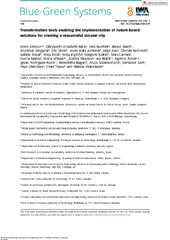Приказ основних података о документу
Transformation tools enabling the implementation of nature-based solutions for creating a resourceful circular city
| dc.creator | Katsou, Evina | |
| dc.creator | Nika, Chrysanthi-Elisabeth | |
| dc.creator | Buehler, Devi | |
| dc.creator | Maric, Bruno | |
| dc.creator | Megyesi, Boldizsar | |
| dc.creator | Mino, Eric | |
| dc.creator | Almenar, Javier Babi | |
| dc.creator | Bas, Bilge | |
| dc.creator | Becirovic, Dzenan | |
| dc.creator | Bokal, Sabina | |
| dc.creator | Đolić, Maja | |
| dc.creator | Elginoez, Nilay | |
| dc.creator | Kalnis, Gregoris | |
| dc.creator | Garcia Mateo, Mari-Carmen | |
| dc.creator | Milousi, Maria | |
| dc.creator | Mousavi, Alireza | |
| dc.creator | Rincic, Iva | |
| dc.creator | Rizzo, Agatino | |
| dc.creator | Rodriguez-Roda, Ignasi | |
| dc.creator | Rugani, Benedetto | |
| dc.creator | Salaseviciene, Alvija | |
| dc.creator | Sari, Ramazan | |
| dc.creator | Stanchev, Peyo | |
| dc.creator | Topuz, Emel | |
| dc.creator | Atanasova, Natasa | |
| dc.date.accessioned | 2022-03-04T11:14:40Z | |
| dc.date.available | 2022-03-04T11:14:40Z | |
| dc.date.issued | 2020 | |
| dc.identifier.issn | 2617-4782 | |
| dc.identifier.uri | http://TechnoRep.tmf.bg.ac.rs/handle/123456789/4763 | |
| dc.description.abstract | The linear pattern of production-consumption-disposal of cities around the world will continue to increase the emission of pollutants and stocks of waste, as well as to impact on the irreversible deterioration of non-renewable stocks of raw materials. A transition towards a circular pattern proposed by the concept of 'Circular Cities' is gaining momentum. As part of this urban transition, the emergent use of Nature-based Solutions (NBS) intends to shift public opinion and utilize technology to mitigate the urban environmental impact. In this paper, an analysis of the current research and practical investments for implementing NBS under the umbrella of Circular Cities is conducted. A combined appraisal of the latest literature and a survey of ongoing and completed National-European research and development projects provides an overview of the current enabling tools, methodologies, and initiatives for public engagement. It also identifies and describes the links between facilitators and barriers with respect to existing policies and regulations, public awareness and engagement, and scientific and technological instruments. The paper concludes introducing the most promising methods, physical and digital technologies that may lead the way to Sustainable Circular Cities. The results of this research provide useful insight for citizens, scientists, practitioners, investors, policy makers, and strategists to channel efforts on switching from a linear to a circular thinking for the future of cities. | en |
| dc.rights | openAccess | |
| dc.rights.uri | https://creativecommons.org/licenses/by/4.0/ | |
| dc.source | Blue-Green Systems | |
| dc.subject | assessment methods | en |
| dc.subject | Circular Cities | en |
| dc.subject | Nature-based Solutions | en |
| dc.subject | policies and regulations | en |
| dc.subject | stakeholders' awareness and engagement | en |
| dc.title | Transformation tools enabling the implementation of nature-based solutions for creating a resourceful circular city | en |
| dc.type | article | |
| dc.rights.license | BY | |
| dc.citation.epage | 213 | |
| dc.citation.issue | 1 | |
| dc.citation.other | 2(1): 188-213 | |
| dc.citation.spage | 188 | |
| dc.citation.volume | 2 | |
| dc.identifier.doi | 10.2166/bgs.2020.929 | |
| dc.identifier.fulltext | http://TechnoRep.tmf.bg.ac.rs/bitstream/id/7988/Transformation_tools_enabling_pub_2020.pdf | |
| dc.identifier.wos | 000662193300011 | |
| dc.type.version | publishedVersion |

